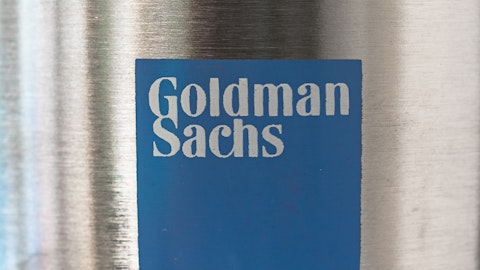David Risinger: Thanks very much. And let me add my congrats on the progress and the guidance raise. So my question is on orforglipron. Novo Nordisk has raised some concerns about the scalability of orforglipron manufacturing given its complexity, I haven’t spoken to Novo directly, but someone told me that they mentioned there are 35 steps in the process. I don’t know if that’s true. But could you please discuss how Lilly is building out its manufacturing capacity and whether the company expects to be able to meet global demand in the Western world after launch in 2026? Or whether we, the investment community, should expect supply constraints and should be guarded about how we try to model orforglipron’s ramp after launch? Thank you.
Joe Fletcher: Thanks, Dave. I’ll hand over to Dave Ricks here.
Dave Ricks: Okay. Great. Dave, great to hear from you. I mean, first of all, it is true that our orforglipron is a complicated large, small molecule, a large small molecule, if you were, and there are many steps in the process. You can read about them in our patent filings, I think. But Lilly, maybe unlike other companies, we made small molecules for a long time. We’re capable of doing it. We understand how to put them together, and we’ve got a defined process to do it for orforglipron. So the API production were a long process and maybe complicated relative to other small molecules is something we’re super confident in and have our arms around. The finish process is really the big advance over using injectables because here, we’re just tablet stamping or tablet – capsule making, which are dry processes, we understand extremely well.
I think the big gain here will be the fact that both for synthetic chemistry and capsule making and tablet making, there is already capacity on planet Earth that is significant. And so unlike the parenteral side where we’ve been talking about injectables and new capacity needs to be built, in which we’re doing aggressively as a not [ph] commented on earlier, here, there’s a lot of partners we can access as well as our own substantial network or dry product go finish [ph] and API production. So pretty confident here. Now when we stick the landing on exact doses and quantities in every instance? We’re not guaranteeing that, but I think the picture will be quite a bit different should orforglipron prove to be safe and effective in the Phase 3 studies.
Again, that’s in 2025, so we can expect launch maybe a year after that, and that’s an important event in the time course of the incretin class.
Joe Fletcher: Thanks Dave. And thanks Dave Risinger for the question. Next question, Paul?
Operator: Next question is coming from Louise Chen from Cantor. Louise, your line is live.
Louise Chen: Hi. Thanks for taking my question. I just wanted to ask you about your next wave of obesity drug. It looks like you’re about half a dozen of these in development. And where do you see the most differentiate yourself?
Dave Ricks: Thanks. Dan, do you want to comment on the earlier phase obesity?
Dan Skovronsky: Yes. Thanks, Louise. We’re excited about the portfolio of earlier-stage obesity molecules. I think there’s a number of opportunities for improvement over – even an excellent drug like tirzepatide. We think about the quality of weight loss as one aspect. So for example, even on tirzepatide, we see the ratio of lean to fat mass approved as patients lose weight on these drugs could we make it improve even faster with the muscle stimulating agents like bimagrumab, but maybe that’s under investigation. Tirzepatide is very well tolerated, but some people stop taking it because of GI side effects. Could we have drugs that have fewer side effects? But maybe that could be possible. Tirzepatide is given as a once a weekly injection, most patients find that to be acceptable, but probably with less frequent injections that could lower the burden on manufacturing and make it easier to use for patients, so that’s another avenue of exploration.
There are some patients who don’t achieve their desired levels of weight loss even on a powerful drug like tirzepatide, and so that’s another avenue. Finally, across different indications, and I spoke earlier of NASH, that are related to metabolic disease. There could be different activities that proved more or less beneficial for these other related diseases. So that’s another avenue of differentiation. I think we’re just at the beginning of probably what will be seen as a multi-decade investments in treating abnormal metabolism and all diseases that come with that. And I’m really proud and pleased that really has what must be the strongest pipeline in this area in the industry.
Dave Ricks: Thank you, Dan. Paul, next question.
Operator: The next question is from Chris Shibutani from Goldman Sachs. Chris, your line is live.
Dave Ricks: Thanks, Chris. Paul, the next question?
Chris Shibutani: Can you hear me?
Dave Ricks: Yes, there you are. Go ahead, Chris.
Chris Shibutani: Great. Thank you. Wanted to ask about supply and dynamic and the demand and when those two might come closer together? Previously, not you been quite specific in your vocabulary and saying that that was something that could possibly happen in 2025. Dave, you were in front of a group that we hosted and I think you gave a little bit of a broader range. What’s the latest that you would like to communicate based upon all the progress that you’re making, the acquisition of Wisconsin facility, et cetera, about a potential timing for that supply-demand dynamic to come closer together?
Dave Ricks: Thanks, Chris. Anat?
Anat Ashkenazi: Yes. Let me start on this. So I would say that, as I said in my prepared remarks, we expect that the supply and demand situation will remain quite tight in the near-term as well as the mid-term. And just to clarify, it’s not that we have a production issue or manufacturing facilities are progressing incredibly well, and I’m incredibly proud of the work done by our M&Q colleagues around the world. Clearly, we have sites working 24/7. We’re doing construction overnight. We’re making the right investments and progressing rapidly as you’ve seen evidence by the results as well as the raise we did for the year. But the demand is strong, but shouldn’t be a surprise given the health benefits that these products provide to patients, highly efficacious and safe medicines.
And I expect that this will continue through the year, even with the significant ramp that we have and we’ll add more supply across different presentations, both with the auto-injector as well as the Kwikpen. But even with that, I expect that the demand will be – will outpace supply through this year, potentially next year, obviously, we’ll see. We’ll continue to invest and ramp as we go into next year, but it could be quite some time. We talked earlier about orforglipron, should we have positive Phase 3 readout that provides another relief valve in terms of just offering a different presentation, as Dave mentioned, which utilizes a different set of infrastructure within our manufacturing organization available capacity globally. So it will be in a stepwise fashion.
We’ll continue to update investors as we progress through the year and coming years.
Dave Ricks: Thanks, Anat. Paul, next question.
Operator: Next question will be from Carter Gould from Barclays. Carter, your line is live.





